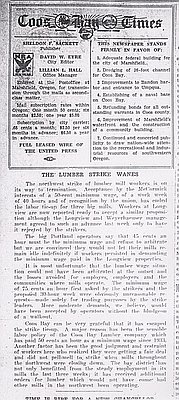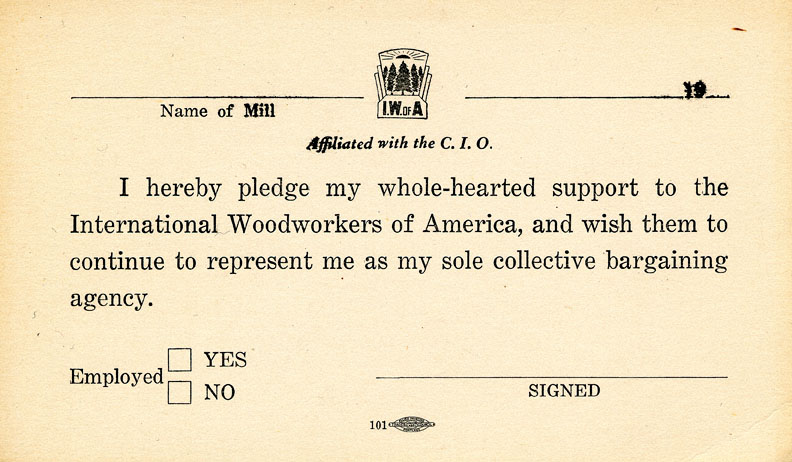- Catalog No. —
- Mss 1505-4-13
- Date —
- 1938
- Era —
- 1921-1949 (Great Depression and World War II), 1950-1980 (New Economy, Civil Rights, and Environmentalism)
- Themes —
- Government, Law, and Politics, Labor, Trade, Business, Industry, and the Economy
- Credits —
- Oregon Historical Society
- Regions —
- Portland Metropolitan
- Author —
- International Woodworkers of America
IWA Membership Card
Shown here is a membership card for the International Woodworkers of America (IWA), a timber workers union. It probably dates to 1937 or 1938, shortly after the union was formed.
The 1930s was a difficult decade for Oregon’s timber workers. From 1929 to 1933, employment in the state’s timber industry declined by more than 60 percent, while wages fell at an even more rapid rate. Moreover, living conditions and safety measures in many logging camps were substandard. Many of the state’s timber workers responded to these deteriorating conditions by organizing labor unions.
In May 1935 about half of the timber workers in the Pacific Northwest went on strike, one of the largest strikes in the region’s history. Most of the striking workers were members of the Sawmill and Timber Workers Union, an American Federation of Labor (AFL) affiliate under the jurisdiction of the International Brotherhood of Carpenters and Joiners. In addition to gaining union recognition, the striking timber workers sought a shorter work week, higher minimum wages, overtime and holiday pay, and seniority rights. Although workers made some modest gains as a result of the three-month strike, most of the union demands were not met.
Some union members blamed the failure of the strike on the Carpenters, who, they argued, conceded too early. The following year saw more discontent among union members after their delegates were snubbed at the Carpenters convention. As a result, some of the Sawmill and Timber Workers Union’s leadership decided to leave the AFL and form their own union affiliated with the newly formed Congress of Industrial Organizations (CIO). In July 1937 they formed the International Woodworkers of America, chartered under the CIO.
Within weeks of the formation of the IWA, a jurisdictional dispute between the IWA and its AFL counterpart, the Lumber and Sawmill Workers Union (LSW), broke out in Portland, shutting down the city’s mills for several months. Conflict between the two unions would continue for decades, even after the AFL and CIO merged in 1955.
Despite the competition with the LSW, the IWA continued to grow through the 1940s and 1950s. By the late 1950s the IWA represented over 100,000 workers at more than 700 companies throughout the United States and Canada. In Oregon the union represented loggers, truck drivers, millworkers, and other forest product workers in more than a dozen communities across the state, including Coos Bay, Bend, Eugene, Garibaldi, Klamath Falls, Prineville, Gold Beach, Heppner, Portland, and Roseburg.
Further Reading:
Lembcke, Jerry, and William M. Tattam. One Union in Wood: A Political History of the International Woodworkers of America. New York, N.Y., 1984.
Written by Cain Allen, © Oregon Historical Society, 2006
Related Historical Records
-
Making a Timber Industry
In 1905, the business of logging had an entire building to celebrate its development. The Forestry Building was Oregon’s unique contribution to the architecture of world’s fairs. It …
-
The Lumber Strike Wanes
This editorial appeared in the Coos Bay Times on May 29, 1935. It describes the 1935 lumber strike, one of the largest labor strikes in Pacific Northwest history. …

